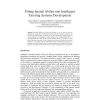1225 search results - page 23 / 245 » Design Principles for Intelligent Environments |
AIED
2007
Springer
14 years 3 months ago
2007
Springer
Building effective learning environments is an art that can only be perfected by a great deal of explorations involving the environments’ audience: the learners. This paper focus...
ICRA
2000
IEEE
14 years 2 months ago
2000
IEEE
This paper discusses a novel approach to combining human and machine intelligence in teleoperation of 6 degree of freedom (DOF) arm manipulators. Two algorithms are presented that...
ACMACE
2005
ACM
14 years 3 months ago
2005
ACM
FreeWill+ is a framework that aims at integrating various animation techniques for controlling human-like characters. With heterogeneity and multi-layering as its main design prin...
AAAI
1997
13 years 11 months ago
1997
This paper argues that complex, embedded software agent systems are best constructed with parallel, layered architectures. These systems resemble Minskian Societies of Mind and Br...
EICS
2009
ACM
14 years 1 months ago
2009
ACM
Ubiquitous computing poses new usability challenges that cut across design and development. We are particularly interested in "spaces" enhanced with sensors, public disp...


